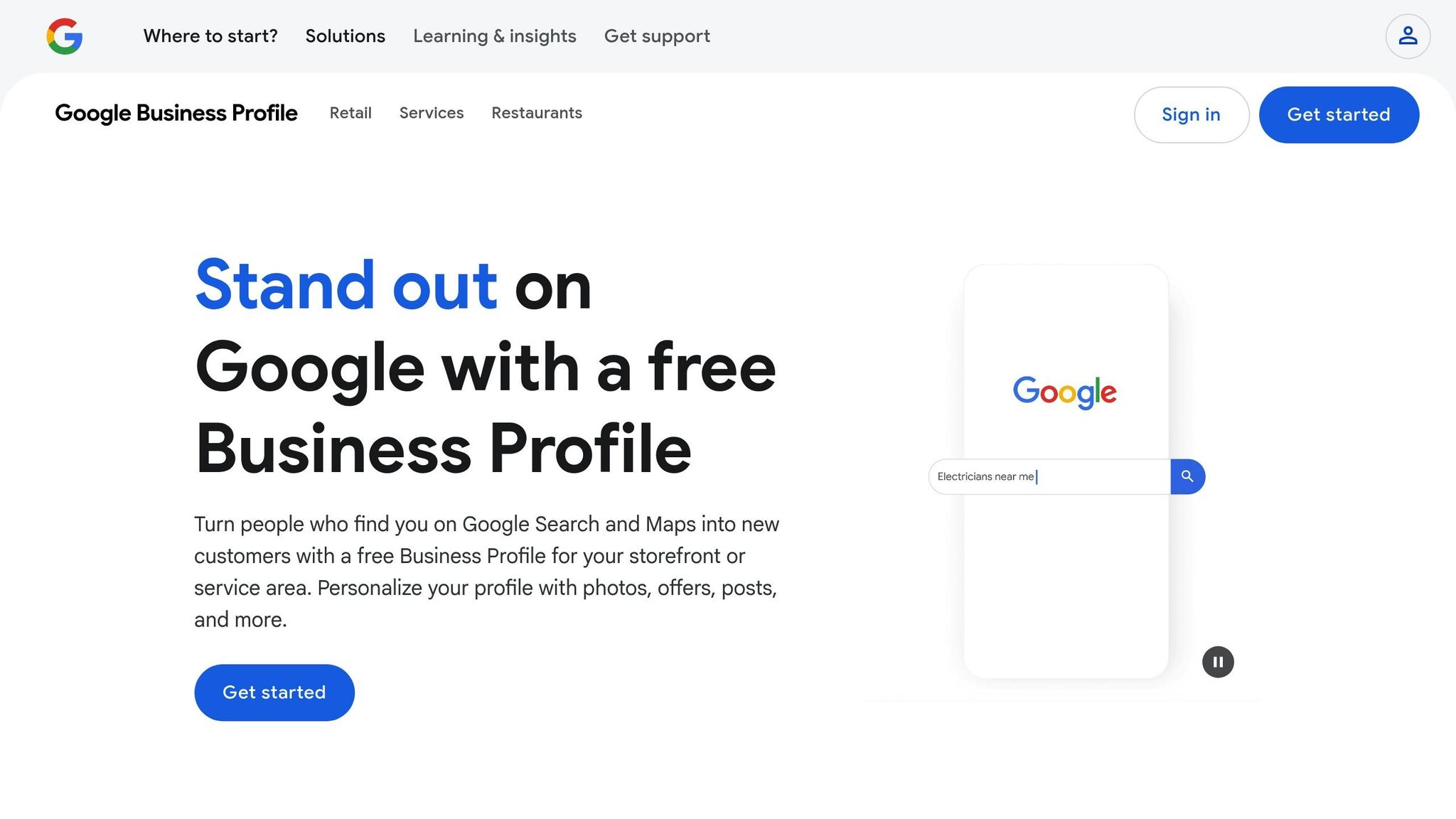Want your law firm to rank higher on Google and attract more clients? This guide breaks down the 7 essential SEO principles attorneys need to succeed online. Here’s what you’ll learn:
- Keyword Research: Find terms your clients actually search for, like “divorce lawyer near me.”
- Expert Content: Create clear, accurate, and trustworthy legal resources.
- Technical Setup: Ensure your website is fast, mobile-friendly, and secure.
- Local SEO: Optimize for “near me” searches and manage your Google Business Profile.
- User Experience: Make your site easy to navigate and client-focused.
- Link Building: Earn quality backlinks from trusted sources.
- Tracking Results: Use tools like Google Search Console to measure success.
These strategies help you rank higher, connect with potential clients, and grow your law firm online. Let’s dive into the details.
SEO For Lawyers: A Step by Step Guide
1. Legal Keyword Research
Keyword research is the backbone of legal SEO. Focus on the actual terms your clients use, not overly technical or industry-specific language.
Look for high-intent keywords that show someone is actively seeking legal help. These typically fall into three categories:
- Practice-specific: Examples include “personal injury lawyer”, “divorce attorney”, or “criminal defense law firm.”
- Location-based: Keywords like “Boston medical malpractice attorney” or “NYC estate planning lawyer.”
- Problem-focused: Phrases like “how to file for bankruptcy” or “what to do after a car accident.”
When prioritizing keywords, consider both search volume and competition. While broad terms like “lawyer” might have a higher search volume, more specific phrases like “employment discrimination attorney” often perform better because they show clear intent and face less competition.
Here’s a simple framework to guide your legal keyword research:
- Start with your core services: List your main practice areas and add location-specific terms. This will form the base of your primary keywords.
- Think like your clients: Use the language they might use to describe their issues. For example, instead of “tort litigation”, they might search for “sue someone for damages” or “file a lawsuit for injury.”
- Understand search intent:
Search Intent Example Keywords Content Type Research “when to hire a lawyer” Educational blogs Comparison “best divorce lawyers near me“ Service pages Action “schedule consultation with attorney” Contact pages
Use this research to create content pillars for each practice area. These sections serve as comprehensive resources, building authority while targeting a range of related keywords. For example, a personal injury lawyer might develop pillars around topics like car accidents, workplace injuries, and medical malpractice.
2. Expert Legal Content
Creating expert legal content starts with thorough keyword research and transforms those insights into reliable, informative resources. The goal is to combine SEO strategies with information that builds trust.
Content Quality Standards
High-quality legal content must meet these three key standards:
- Accuracy: Provide correct and up-to-date legal information.
- Clarity: Use simple, clear language that clients can easily understand.
- Credibility: Showcase your legal expertise while adhering to ethical practices.
Organizing Content Pillars
Structure your legal content into well-defined topic clusters. For instance, a personal injury law firm could organize content like this:
| Topic Pillar | Supporting Content | Purpose |
|---|---|---|
| Car Accidents | – Fault determination – Insurance claims – Settlement negotiations |
Builds expertise in vehicle-related injury cases |
| Workplace Injuries | – Workers’ compensation – OSHA violations – Third-party claims |
Highlights knowledge in workplace and employment law |
| Medical Malpractice | – Types of negligence – Statute of limitations – Damage calculations |
Demonstrates proficiency in healthcare-related cases |
Writing to Build Trust and Drive Action
Help potential clients navigate their legal issues by:
- Addressing their specific concerns with actionable solutions.
- Including case studies to illustrate real-world applications.
- Citing current laws and legal precedents to back up your advice.
- Adding clear calls-to-action, such as consultation offers, to encourage engagement.
SEO-Friendly Content Structure
To ensure your content ranks well, focus on:
- Using keyword-optimized headers.
- Writing short, scannable paragraphs.
- Incorporating internal links to relevant pages.
- Keeping content updated to reflect the latest legal standards.
Adhere to state bar ethical rules and maintain a consistent publishing schedule to show reliability and stay visible in search rankings. Additionally, make sure your website’s technical setup supports this content for the best SEO performance.
3. Website Technical Setup
A well-structured website not only aligns with Google’s standards but also ensures a smooth experience for users. These technical aspects are key to your law firm’s SEO success and work hand-in-hand with your content strategy.
- Core Web Vitals
Focus on these metrics:
| Metric | Target | Why It Matters for Law Firms |
|---|---|---|
| Loading Speed | Under 2.5 seconds | Reduces bounce rates, keeping potential clients engaged |
| Interactivity | Under 100ms | Ensures quick, seamless actions like form submissions |
| Visual Stability | Under 0.1 CLS | Prevents layout shifts, offering a consistent reading experience |
- Mobile-First Design
Make sure your site is mobile-friendly by:- Using responsive layouts with buttons at least 44×44 pixels in size
- Keeping text legible with a font size of at least 16px
- Ensuring forms and contact details are easy to find and use
- Security Measures
Boost your site’s security with:- SSL certificates (HTTPS)
- Regular security checks
- Safe and encrypted contact forms
- Adherence to privacy policies and legal standards
- Technical Content Setup
Help search engines understand your site better with:- Schema markup for law firm-specific details
- An XML sitemap for better indexing
- A robots.txt file to guide search engine crawlers
- Clear, logical URLs (e.g., example.com/practice-areas/personal-injury)
- Page Speed Improvements
Enhance loading times by:- Compressing images and using optimized file formats
- Enabling browser caching
- Minifying CSS, JavaScript, and HTML
- Leveraging a Content Delivery Network (CDN)
- Accessibility Features
Make your site accessible to all users by:- Adding descriptive alt text to images
- Using proper heading structures
- Ensuring sufficient color contrast for readability
- Supporting keyboard navigation for easier use
These technical elements create a solid foundation for both search engines and users, ensuring your website performs effectively on all fronts.
4. Law Firm Local Search
Being visible in local search results is crucial since most clients look for legal services nearby. Here’s how you can strengthen your local SEO strategy.
Google Business Profile Optimization

Ensure your Google Business Profile is fully optimized by:
- Verifying ownership of your business profile
- Providing accurate business hours, phone numbers, and address
- Uploading high-quality office photos and professional headshots of attorneys
- Choosing the right categories for your practice areas
- Writing a detailed business description with relevant keywords
- Keeping your NAP (Name, Address, Phone) information consistent across platforms
Local Content Strategy
Develop content tailored to your target audience and specific locations:
| Content Type | Purpose | Example Topics |
|---|---|---|
| Practice Area Pages | Highlight specific services | “Personal Injury Law in Boston” |
| Location Pages | Cover your service areas | “Family Law Services in Downtown Manhattan” |
| Local Legal Guides | Address local legal issues | “California Divorce Laws Guide” |
| Community Updates | Show involvement locally | “Legal Aid Programs in Chicago” |
Local Citation Building
Boost your presence on trusted local directories by listing your firm in:
- State bar association directories
- Local chambers of commerce
- Legal directories like Avvo, FindLaw, and Martindale
- Industry-specific business directories
- Local news websites and publications
Review Management
Client reviews play a key role in building trust. Focus on:
- Making it easy for clients to leave reviews
- Responding professionally to all feedback, positive or negative
- Featuring client testimonials on your website
- Regularly monitoring and managing your online reputation
Local Link Building
Strengthen your authority through connections in your community:
- Collaborate with local organizations and charities
- Participate in community events
- Write for local legal publications
- Join regional legal associations
- Sponsor events or initiatives in your area
Geographic Service Area Targeting
Target individual service areas effectively with optimized pages:
- Create a dedicated page for each major service location
- Use schema markup to define your service areas
- Mention local landmarks or reference points in your content
- Optimize meta descriptions with location-specific keywords
- Link your location pages internally for better navigation
5. Website User Experience
Once your website’s technical setup is solid, the next step is making it user-friendly. A well-designed user experience encourages visitors to stay longer and engage with your law firm. Here’s how to improve usability and boost engagement.
Clear Navigation Structure
Your website’s navigation should make it easy for visitors to find what they’re looking for. Here’s a breakdown:
| Navigation Element | Purpose | Best Practice |
|---|---|---|
| Main Menu | Show primary service areas | Keep it simple with 5–7 main categories |
| Practice Area Pages | Detail your services | Use descriptive URLs and breadcrumbs |
| Contact Information | Make reaching you easy | Include on every page with click-to-call |
| Resource Center | Offer educational content | Organize by topic and difficulty level |
| Case Results | Highlight expertise | Add filters for practice area and outcomes |
A well-structured menu and smooth navigation on all devices are essential for a seamless user experience.
Mobile-First Design
Since most legal searches happen on mobile devices, your site needs to work perfectly on smaller screens. Make sure it:
- Loads in under 3 seconds
- Features touch-friendly buttons and forms
- Uses a single-column layout for mobile
- Has enough spacing between clickable elements
Content Organization
Use content pillars to structure your pages logically. This helps visitors and search engines understand your site better, making navigation easier and boosting engagement.
Conversion Elements
Strategic calls-to-action (CTAs) are key to turning visitors into clients. Add elements like:
- Free consultation buttons
- Contact forms on every practice area page
- Live chat options
- Emergency contact details
- Case evaluation forms
Fast-loading pages also play a role in improving conversions.
Page Load Speed
Improve your site’s speed by compressing images, minifying code, enabling caching, and using a CDN. Faster pages mean happier users.
Trust Indicators
Show potential clients they can rely on you by including:
- Attorney credentials and certifications
- Memberships in professional associations
- Recent case results
- Client testimonials (photos add a personal touch)
- Awards and recognitions
“Great content doesn’t just inform – it persuades.” – RankWriters [1]
Accessibility Features
Make your site usable for everyone, including those with disabilities. Add features like:
- Alt text for images
- Proper color contrast
- Keyboard navigation
- Video transcripts
- Screen reader support
These user experience updates, combined with technical optimizations, can significantly improve client engagement and conversions.
6. Building Quality Links
Creating strong backlinks is a key way to improve your law firm’s online presence. Here are some practical methods to strengthen your link profile:
Legal Directory Submissions
List your firm in trusted legal directories that verify credentials. This not only builds backlinks but also helps potential clients find you.
Content-Based Link Building
Publish detailed legal guides, case studies, or unique research. Quality content like this can naturally attract links from credible websites.
Building Relationships
Connect with well-known legal organizations and publications. Contribute expert opinions or collaborate on informative pieces to earn valuable backlinks.
Focus on Quality Links
It’s better to have a few links from respected sources than many from less reliable ones. A single link from a trusted legal authority can carry more weight than dozens of low-quality links. When paired with strong on-site SEO and authoritative content, these links can significantly boost your firm’s visibility.
These strategies work hand-in-hand with your broader SEO efforts to improve your search rankings.
7. SEO Results Tracking
Monitoring your SEO performance helps you identify what’s working and where improvements are needed. Dive into each metric to see how it contributes to your overall success.
Keyword Growth Tracking
Google Search Console is a great tool for keeping tabs on keyword rankings. Compare your current rankings to previous periods to see how you’re progressing.
Lead Generation Metrics
To measure the impact of your SEO efforts, focus on tracking:
- Phone calls that originate from organic search
- Website inquiry form submissions from potential leads
Monthly Performance Review
Set up a straightforward dashboard to keep an eye on your key metrics:
| Metric | What to Track | Why It Matters |
|---|---|---|
| Keyword Growth | Changes in keyword rankings | Shows how your SEO is improving |
| Call Volume | Calls generated from search | Demonstrates direct business impact |
| Form Submissions | Completed inquiry forms | Tracks lead generation efforts |
Regularly reviewing these metrics each month helps you make informed adjustments to your SEO strategy. This process works hand in hand with on-site improvements and quality link-building to strengthen your overall approach.
Conclusion
Use these seven SEO principles to improve your law firm’s online presence and bring in more clients. With 75.1% of clicks going to the top three Google results [1], getting these strategies right is essential for your firm’s digital growth.
By combining smart keyword research, well-written content, a solid technical setup, local search optimization, and a strong user experience, you can improve your rankings and attract more qualified leads. For example, a law firm that applied these methods in Q1 2024 achieved impressive results in just three months: page #1 rankings for over 20 keywords, a 40% increase in organic traffic, and more than 11 new SERP features [1].
Don’t forget to focus on building quality backlinks and consistently tracking SEO metrics to ensure your strategy stays effective. SEO requires regular updates and fine-tuning to maintain success.
If managing this process feels overwhelming, professional help can make a big difference. RankWriters specializes in crafting persuasive, SEO-friendly content tailored specifically for law firms. As they put it:
“Great content doesn’t just inform – it persuades.” [1]







